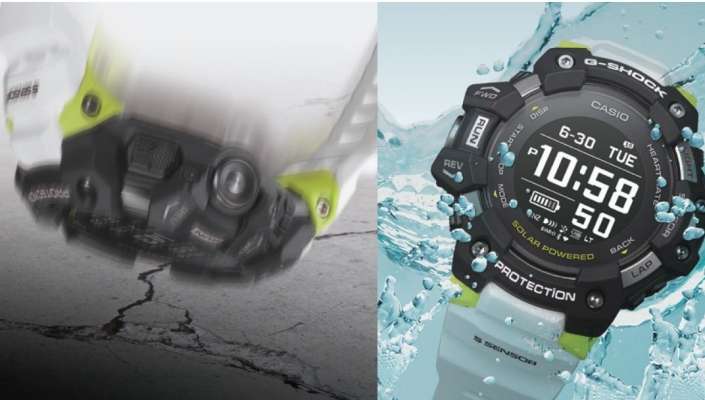Casio just announced the newest model in the GSQUAD range, the Casio G-Shock GBD-H1000 , enabled with all the sensors you'll need in a fitness watch, including an optical heart rate sensor, barometer, and even GPS.
With the GBD-H1000, Casio is seemingly behind active folks who favor traditional watch brands and find the look of the Fitbit Versa 2 and Garmin Venu a bit too weak. The Casio G-Shock GBD-H1000 will retail for € 399, € 200 above the Fitbit Versa 2's regular retail price and at the same price as the Apple Watch Series 5, so we expect some pretty solid functionality for this price.

Special features for athletes
The spec sheet, sent along with the press release, has a lot to say, but as much as it shows many very promising features, some questions remain unanswered (for example, the screen resolution?). What we do know is that the Casio G-Shock GBD-H1000 will be shock resistant, water resistant to 200 meters , use GPS / GLONASS / QZSS for position tracking (not GALILEO though), and have a range of other sensors. , as:
Optical heart rate sensor
Optical sensors on the back of the watch detect the flow of blood under the skin and measure the heart rate. The heart rate monitor determines the data using an optical light sensor, measuring up to 220bpm. The LED light penetrates the skin and the blood vessels underneath. Depending on the volume of blood, the light is either absorbed or reflected. The optical sensor measures the reflected light, allowing to determine the pulse of the current.
Additionally, other sensors in the watch measure acceleration (step counter), magnetic direction (compass), pressure (altimeter / barometer), and temperature (thermometer). These five highly accurate sensor functions measure activity status in real time and especially outdoors.
GPS sensor
It acquires data from the current location of the GPS satellite, measures the distance traveled, speed, pace and other data. Once it receives the GPS signal, it accurately measures every second or every minute (consumes less power). Easily switch between these modes for different activities. For example, a long walk requires less precision compared to a run. Depending on the selected measurement mode, you can secure the battery and extend its life. In addition to GPS, the watch acquires data from the GLONASS and Michibiki satellite systems. You can only record your trajectory but not navigate to a target.
Shock and water resistance
It uses a waterproof charging terminal and offers water resistance up to 200 meters even with a built-in optical sensor that measures heart rate at the wrist. Shock-resistant construction protects module. A complex and robust shape avoids direct blows to the glass and buttons.

VO2 Max meter
It uses heart rate and speed when running to calculate the maximum oxygen consumption per kilogram of body weight in one minute (ml / kg / min). It reflects the process of carrying oxygen to the body through the lungs to the muscles.
This can be used as a benchmark for cardiorespiratory fitness when the user is trying to build endurance for running or other sports.
The higher your VO2max score, the better your health, quality of life and performance. Measuring your performance capacity is also important to customize your calorie count and your training programs.
Solar energy charging
The time mode (includes the step counter and the notification function) can be powered only by solar charging. When charged for about eight hours a day under indoor fluorescent lighting (500 lux), and charged on a sunny day for two hours in a week (10,000 lux).
Continuous operation in time mode (includes step counter and notification functions) can be used for up to 12 months without solar power.
The training mode (GPS with 1 sec reception + HRM) can be used continuously for up to 14 hours with a fully charged battery.
The watch has all the Fitness metrics you need
In addition to all the above sensory trackers, the Casio G-Shock GBD-H1000 will also be able to provide you with an estimate of VO2 max, assess training status and fitness level, and measure training load as well as recovery time. It would be nice to know which sports can actually be tracked with the Casio G-Shock GBD-H1000 and also the application compatibility.
Of the latter, Casio said the following: " By connecting the watch with a dedicated application on a smartphone, the user can manage the history of measurement data, such as calories burned and recorded trips ."
At the same time, the Casio G-Shock GBD-H1000 can store up to 100 runs in its training log , also up to 140 lap records per race and metrics such as elapsed time, distance, pace, calories burned, heart rate, maximum heart rate. . rate, aerobic training effect, anaerobic training effect.
All of this wouldn't be necessary for a pedometer, so there's hope that at least some sports modes will be available pre-installed on the watch.
The Casio GBD-H1000 will be available in four colors , two of which look very similar. You can find it now online and in physical stores for € 399 .
